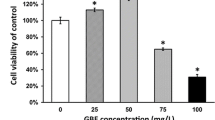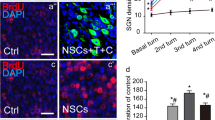Abstract
Nerve growth factor (NGF) is a neurotrophic factor that modulates survival and differentiation of neural stem cells (NSCs). We investigated the function of NGF in promoting growth and neuronal differentiation of NSCs isolated from mouse cochlear tissue, as well as its protective properties against gentamicin (GMC) ototoxicity. NSCs were isolated from the cochlea of mice and cultured in vitro. Effect of NGF on survival, neurosphere formation, and differentiation of the NSCs, as well as neurite outgrowth and neural excitability in the subsequent in vitro neuronal network, was examined. Mechanotransduction capacity of intact cochlea and auditory brainstem response (ABR) threshold in mice were also measured following GMC treatment to evaluate protection using NGF against GMC-induced neuronal hearing loss. NGF improved survival, neurosphere formation, and neuronal differentiation of mouse cochlear NSCs in vitro, as well as promoted neurite outgrowth and neural excitability in the NSC-differentiated neuronal culture. In addition, NGF protected mechanotransduction capacity and restored ABR threshold in gentamicin ototoxicity mouse model. Our study supports a potential therapeutic value of NGF in promoting proliferation and differentiation of NSCs into functional neurons in vitro, supporting its protective role in the treatment of neuronal hearing loss.







Similar content being viewed by others

References
Korsching S (1993) The neurotrophic factor concept: a reexamination. J Neurosci 13:2739–2748
Lewin GR, Barde YA (1996) Physiology of the neurotrophins. Annu Rev Neurosci 19:289–317. doi:10.1146/annurev.ne.19.030196.001445
Sofroniew MV, Howe CL, Mobley WC (2001) Nerve growth factor signaling, neuroprotection, and neural repair. Annu Rev Neurosci 24:1217–1281. doi:10.1146/annurev.neuro.24.1.1217
Huang EJ, Reichardt LF (2001) Neurotrophins: roles in neuronal development and function. Annu Rev Neurosci 24:677–736. doi:10.1146/annurev.neuro.24.1.677
Reichardt LF (2006) Neurotrophin-regulated signalling pathways. Philos Trans R Soc Lond B Biol Sci 361:1545–1564. doi:10.1098/rstb.2006.1894
Hallbook F (1999) Evolution of the vertebrate neurotrophin and Trk receptor gene families. Curr Opin Neurobiol 9:616–621. doi:10.1016/S0959-4388(99)00011-2
Levi-Montalcini R (1987) The nerve growth factor 35 years later. Science 237:1154–1162
Northcutt RG (1989) Body and Brain. A Trophic Theory of Neural Connections. Dale Purves. Harvard University Press, Cambridge, MA, 1988. viii, 231 pp., illus. $35. Science 244:993. doi:10.1126/science.244.4907.993
Gage FH (2000) Mammalian neural stem cells. Science 287:1433–1438
Nakatomi H, Kuriu T, Okabe S, Yamamoto S, Hatano O, Kawahara N, Tamura A, Kirino T, Nakafuku M (2002) Regeneration of hippocampal pyramidal neurons after ischemic brain injury by recruitment of endogenous neural progenitors. Cell 110:429–441
Russo I, Barlati S, Bosetti F (2011) Effects of neuroinflammation on the regenerative capacity of brain stem cells. J Neurochem 116:947–956
Chaddah R, Arntfield M, Runciman S, Clarke L, van der Kooy D (2012) Clonal neural stem cells from human embryonic stem cell colonies. J Neurosci 32:7771–7781
Yuan Y, Wang Y, Chi F (2014) Reinnervation of hair cells by neural stem cell-derived neurons. Chin Med J (Engl) 127:2972–2976
Hu Z, Wei D, Johansson CB, Holmstrom N, Duan M, Frisen J, Ulfendahl M (2005) Survival and neural differentiation of adult neural stem cells transplanted into the mature inner ear. Exp Cell Res 302:40–47
Coleman B, Fallon JB, Pettingill LN, de Silva MG, Shepherd RK (2007) Auditory hair cell explant co-cultures promote the differentiation of stem cells into bipolar neurons. Exp Cell Res 313:232–243
Matsumoto M, Nakagawa T, Higashi T, Kim TS, Kojima K, Kita T, Sakamoto T, Ito J (2005) Innervation of stem cell-derived neurons into auditory epithelia of mice. Neuroreport 16:787–790
Panchision DM, Chen HL, Pistollato F, Papini D, Ni HT, Hawley TS (2007) Optimized flow cytometric analysis of central nervous system tissue reveals novel functional relationships among cells expressing CD133, CD15, and CD24. Stem Cells 25:1560–1570. doi:10.1634/stemcells.2006-0260
Oshima K, Senn P, Heller S (2009) Isolation of sphere-forming stem cells from the mouse inner ear. Methods Mol Biol 493:141–162. doi:10.1007/978-1-59745-523-7_9
Yadav K, Singhal N, Rishi V, Yadav H (2001) Cell Proliferation Assays. In: eLS. Wiley, Hoboken. doi:10.1002/9780470015902.a0002566
Chen P, Johnson JE, Zoghbi HY, Segil N (2002) The role of Math1 in inner ear development: uncoupling the establishment of the sensory primordium from hair cell fate determination. Development 129:2495–2505
Doetzlhofer A, Basch ML, Ohyama T, Gessler M, Groves AK, Segil N (2009) Hey2 regulation by FGF provides a Notch-independent mechanism for maintaining pillar cell fate in the organ of Corti. Dev Cell 16:58–69. doi:10.1016/j.devcel.2008.11.008
Kawashima Y, Geleoc GS, Kurima K, Labay V, Lelli A, Asai Y, Makishima T, Wu DK, Della Santina CC, Holt JR, Griffith AJ (2011) Mechanotransduction in mouse inner ear hair cells requires transmembrane channel-like genes. J Clin Invest 121:4796–4809. doi:10.1172/JCI60405
Pan BF, Geleoc GS, Asai Y, Horwitz GC, Kurima K, Ishikawa K, Kawashima Y, Griffith AJ, Holt JR (2013) TMC1 and TMC2 are components of the mechanotransduction channel in hair cells of the mammalian inner ear. Neuron 79:504–515. doi:DOI:10.1016/j.neuron.2013.06.019
Qin Z, Wood M, Rosowski JJ (2010) Measurement of conductive hearing loss in mice. Hear Res 263:93–103. doi:10.1016/j.heares.2009.10.002
Meiri KF, Pfenninger KH, Willard MB (1986) Growth-associated protein, GAP-43, a polypeptide that is induced when neurons extend axons, is a component of growth cones and corresponds to pp46, a major polypeptide of a subcellular fraction enriched in growth cones. Proc Natl Acad Sci USA 83:3537–3541
Thomas AP, Bird GS, Hajnoczky G, Robb-Gaspers LD, Putney JW Jr (1996) Spatial and temporal aspects of cellular calcium signaling. FASEB J 10:1505–1517
Pacey L, Stead S, Gleave J, Tomczyk K, Doering L (2006) Neural stem cell culture: neurosphere generation, microscopical analysis and cryopreservation. Protocol Exchange. doi:10.1038/nprot.2006.215
Hu Z, Ulfendahl M, Olivius NP (2005) NGF stimulates extensive neurite outgrowth from implanted dorsal root ganglion neurons following transplantation into the adult rat inner ear. Neurobiol Dis 18:184–192
Urbanska M, Blazejczyk M, Jaworski J (2008) Molecular basis of dendritic arborization. Acta Neurobiol Exp 68:264–288
Sobkowicz HM, August BK, Slapnick SM (2002) Influence of neurotrophins on the synaptogenesis of inner hair cells in the deaf Bronx waltzer (bv) mouse organ of Corti in culture. Int J Dev Neurosci 20:537–554
Salvinelli F, Casale M, Greco F, Trivelli M, Di Peco V, Amendola T, Antonelli A, Stampachiacchiere B, Aloe L (2002) Nerve growth factor serum level is reduced in patients with sensorineural hearing impairment: possible clinical implications. J Biol Regul Homeost Agents 16:176–180
Funding
This work was supported by grant from the National Natural Science Foundation of China (NSFC, 81371093) to Zhao Han.
Author information
Authors and Affiliations
Corresponding authors
Ethics declarations
Conflict of interest
The authors declare that they have no conflict of interest.
Research involving animal rights
All applicable international, national, and/or institutional guidelines for the care and use of animals were followed.
Informed consent
Not applicable.
Additional information
Zhao Han and Cong-Pin Wang have contributed equally to this paper.
Electronic supplementary material
Below is the link to the electronic supplementary material.
Rights and permissions
About this article
Cite this article
Han, Z., Wang, CP., Cong, N. et al. Therapeutic value of nerve growth factor in promoting neural stem cell survival and differentiation and protecting against neuronal hearing loss. Mol Cell Biochem 428, 149–159 (2017). https://doi.org/10.1007/s11010-016-2925-5
Received:
Accepted:
Published:
Issue Date:
DOI: https://doi.org/10.1007/s11010-016-2925-5



